How to Shut Down or Restart Windows
![]()
![]()
![]() This article covers Windows 7 and earlier only.
This article covers Windows 7 and earlier only.
![]() Click here for the article on How to Shut Down or Restart Windows 8.
Click here for the article on How to Shut Down or Restart Windows 8.
Introduction
This article will show you how to shut down or restart your computer or laptop running Microsoft Windows. In short:
- Shut down turns off the computer or device completely.
- Restart turns it off and immediately turns it back on and starts Windows again.
Both of these actions will log off all users that are logged on at the time, forcibly closing all application programs. Windows will then save its system data, and close the Windows program itself properly, before shutting down the computer. When you initiate a shut down correctly as described below, Windows will also notice if you have any files open that haven't been saved, and prompt you to save them before it continues shutting down. But, it won't do this for any other users that are logged on at the time (such as through Remote Desktop), so you should tell anyone who might have anything open on your computer before you shut it down.
Below are details about each option, and how to do it for your version of Windows. Click the links below to jump to the section you need.
Note: These instructions assume you are logged on already, to avoid having this page get more cluttered than it already is. You may notice icons or buttons on the screen while you're logged off or the computer is locked, which you can use to shut down or restart, similar to how you do it while logged on.
Note: The Microsoft Windows operating system is very customizable, so your computer may not look or act exactly as described here.
Quick Links on this page:
Shut Down
On a computer running Microsoft Windows, properly initiating a shut down tells Windows to log off all active user accounts and clean up everything else it's doing, and then power down your computer. When you shut down properly, this is referred to as a graceful shutdown. In contrast, if you just pull the plug on a desktop computer, then the next time you start it up, Windows may tell you that it was not shut down properly, admonish you not to do that any more, and scan your disk for errors that might have been caused by the ungraceful shutdown.
You only need to shut down a desktop computer if you are going to unplug it (such as to move to another desk), or to prepare for a planned power outage in the building. You never really need to shut down a modern laptop, so long as you charge the battery regularly. If you're going to put your laptop away for a long time, though, you should shut it down so the battery doesn't die.
On really old computers (from the 1990s), once you've followed the appropriate procedure below to shut down gracefully with the keyboard or mouse, Windows will clean up and close down, but your computer won't actually turn off. Instead, you will see a message on a black screen saying "It is now safe to turn off your computer." This means Windows is at the point where it would physically shut off your computer, but it can't, because your computer's hardware does not support being turned off by Windows. Once you see this message, you can simply use the power switch to turn off your computer.
Quick Links in this section:
Shut Down Using the Power Button 
On modern computers and laptops, the power button has a symbol on it like this ![]() and is not simply a mechanical switch that cuts off power. On most desktop computers, pressing this button will tell Windows to initiate a proper Windows shut down (unless Windows has been reconfigured to do something else; how to do this is outside the scope of this article). If the button is easy to reach (that is, your computer isn't under a desk or something), then test it: close all your programs and press the button on your computer, and watch the screen carefully to see what happens. You should see a message that Windows is logging off, then a message that it's shutting down, and then it should shut off completely. If it does anything else, or you're not sure, then use another method listed on this page to shut down your computer.
and is not simply a mechanical switch that cuts off power. On most desktop computers, pressing this button will tell Windows to initiate a proper Windows shut down (unless Windows has been reconfigured to do something else; how to do this is outside the scope of this article). If the button is easy to reach (that is, your computer isn't under a desk or something), then test it: close all your programs and press the button on your computer, and watch the screen carefully to see what happens. You should see a message that Windows is logging off, then a message that it's shutting down, and then it should shut off completely. If it does anything else, or you're not sure, then use another method listed on this page to shut down your computer.
If you have a computer from the 1990s and the power button doesn't have this symbol, or it's an actual mechanical switch, then you likewise must follow one of the procedures below to shut down Windows using the mouse or keyboard.
Click here to see photographs of power switches on various computers over the years.
Shut Down Using the Mouse 
![]() Windows 7
Windows 7
Click ![]() . You should see Shut down right there, as in the image below. If so, click on it.
. You should see Shut down right there, as in the image below. If so, click on it.
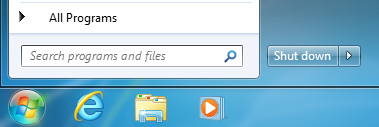
If the button shows something else, there is a tiny arrow ![]() just to the right of it. Click that—it's a little difficult, because you have to click only on the tiny arrow. When you click the arrow, a new menu will pop up. Click Shut down.
just to the right of it. Click that—it's a little difficult, because you have to click only on the tiny arrow. When you click the arrow, a new menu will pop up. Click Shut down.
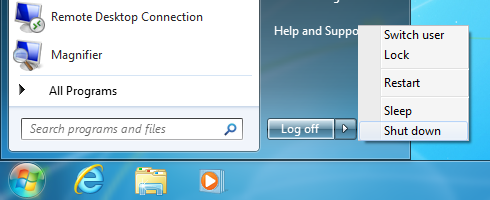
![]() Windows Vista
Windows Vista
Click ![]() . You should see the shutdown button
. You should see the shutdown button ![]() right there, as in the image below. Click it.
right there, as in the image below. Click it.
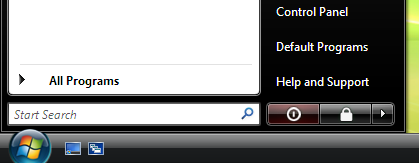
![]() Windows XP
Windows XP
Click ![]() then
then ![]() Shut Down. A message box will appear with options; select Shut down then click OK.
Shut Down. A message box will appear with options; select Shut down then click OK.
![]() Windows Me
Windows Me
![]() Windows 2000
Windows 2000
![]() Windows 98
Windows 98
![]() Windows 95
Windows 95
![]() Windows NT 4.0
Windows NT 4.0
Click ![]() then click Shut down. A message box will appear with options; select Shut down then click OK or Yes.
then click Shut down. A message box will appear with options; select Shut down then click OK or Yes.
![]() Windows NT 3.x
Windows NT 3.x
In the Program Manager main window, click File then Shutdown. In the window that pops up, select Shutdown. Click OK.
![]() Windows 3.x
Windows 3.x
In the Program Manager main window, click File then Exit Windows, then click OK. Windows will exit, and return you to the MS-DOS command prompt. At this point, you can safely shut off your computer using the power switch.
Shut Down Using the Keyboard 
Please note that any of the following are the same key:
![]()
![]()
![]()
This is the Microsoft Windows Logo Key. The logo has changed over the years, but it works the same on any keyboard regardless of its appearance. If your computer does not have such a key at all, you can substitute Ctrl+Esc.
![]() Windows 7
Windows 7
![]() Windows Vista
Windows Vista
Press CtrlAlt+Del. Wait until the screen switches to something like the image below, then press Alt+S. A menu will pop up. Use ⇧ to highlight Shut Down, then press Enter.
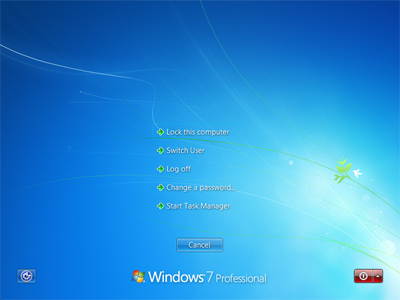
![]() Windows XP
Windows XP
![]() Windows 2000
Windows 2000
![]() Windows NT 4.0
Windows NT 4.0
Press ![]() then U. A selection window will appear. Press S, repeatedly if necessary, until the Shutdown option is selected (and not Stand By or Switch User), then press Enter.
then U. A selection window will appear. Press S, repeatedly if necessary, until the Shutdown option is selected (and not Stand By or Switch User), then press Enter.
Note: In these versions of Windows, you can also use CtrlAlt+Del then S to get to the selection window. But, the above procedure is a little easier.
![]() Windows Me
Windows Me
![]() Windows 98
Windows 98
![]() Windows 95
Windows 95
Press CtrlAlt+Del then Alt+S.
![]() Windows NT 3.x
Windows NT 3.x
Press CtrlAlt+Del, S, S, then Enter.
![]() Windows 3.x
Windows 3.x
Use Alt+Tab to get to the Program Manager main window. Press Alt+F4 then Enter. Windows will exit, and return you to the MS-DOS command prompt. At this point, you can safely shut off your computer using the power switch.
Restart
The Restart option shuts down Windows, turns off your computer, and immediately turns it back on and starts Windows, bringing you to the sign-in screen to start a fresh computing session. You typically do this if the computer or Windows itself seems to be malfunctioning, in hopes that clearing the working memory and starting it up fresh will fix it.
If your computer has a reset button on the front panel, you should not use this, as it has no connection with Windows and will immediately restart the computer, without giving Windows a chance to sign off users or clean up properly.
Quick Links in this section:
Restart Using the Mouse 
![]() Windows 7
Windows 7
Click ![]() . There is a tiny arrow
. There is a tiny arrow ![]() there. Click that—it's a little difficult, because you have to click only on the tiny arrow. When you click the arrow, a new menu will pop up. Click Restart.
there. Click that—it's a little difficult, because you have to click only on the tiny arrow. When you click the arrow, a new menu will pop up. Click Restart.
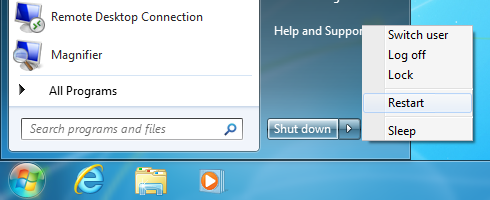
![]() Windows Vista
Windows Vista
Click ![]() . Click the tiny arrow
. Click the tiny arrow ![]() to bring up the menu, as seen below. Click Restart.
to bring up the menu, as seen below. Click Restart.
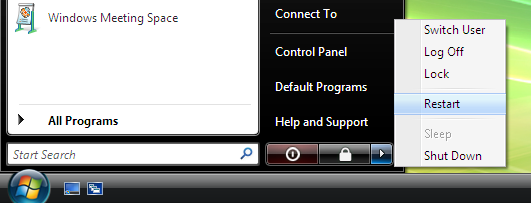
![]() Windows XP
Windows XP
Click ![]() then click
then click ![]() Shut Down. A message box will appear with options; select Restart then click OK.
Shut Down. A message box will appear with options; select Restart then click OK.
![]() Windows Me
Windows Me
![]() Windows 2000
Windows 2000
![]() Windows 98
Windows 98
![]() Windows 95
Windows 95
![]() Windows NT 4.0
Windows NT 4.0
Click ![]() then click Shut down. A message box will appear with options; select Restart then click OK or Yes.
then click Shut down. A message box will appear with options; select Restart then click OK or Yes.
![]() Windows NT 3.x
Windows NT 3.x
In the Program Manager main window, click File then Shutdown. In the window that pops up, select Shutdown and Restart. Click OK.
![]() Windows 3.x
Windows 3.x
In the Program Manager main window, click File then Exit Windows, then click OK. Windows will exit, and return you to the MS-DOS command prompt. At this point, you can safely shut off your computer using the power switch then turn it back on, or press the hardware restart button if your computer has one.
Restart Using the Keyboard 
Please note that any of the following are the same key:
![]()
![]()
![]()
This is the Microsoft Windows Logo Key. The logo has changed over the years, but it works the same on any keyboard regardless of its appearance. If your computer does not have such a key at all, you can substitute Ctrl+Esc.
![]() Windows 7
Windows 7
![]() Windows Vista
Windows Vista
Press CtrlAlt+Del. Wait until the screen switches to something like the image below, then press Alt+S then Alt+R.

![]() Windows XP
Windows XP
![]() Windows 2000
Windows 2000
![]() Windows NT 4.0
Windows NT 4.0
Press ![]() then U. A selection window will appear. Press R, then Enter.
then U. A selection window will appear. Press R, then Enter.
Note: In these versions of Windows, you can also use CtrlAlt+Del then S to get to the selection window. But, the above procedure is a little easier.
![]() Windows Me
Windows Me
![]() Windows 98
Windows 98
![]() Windows 95
Windows 95
Press ![]() then U. A selection window will appear. Press R, then Enter.
then U. A selection window will appear. Press R, then Enter.
Note: In these versions of Windows, do not use CtrlAlt+Del to restart. If you press CtrlAlt+Del in these versions of Windows, the window that pops up provides a button only to shut down gracefully. There is no option to restart gracefully. There is, however, a message telling you that you can press CtrlAlt+Del again to restart, but this does not gracefully restart; it instead will cause an immediate hardware reset, with no chance for Windows to clean up or for you to save any files you might have left open.
![]() Windows NT 3.x
Windows NT 3.x
Press CtrlAlt+Del, S, R, then Enter.
![]() Windows 3.x
Windows 3.x
Use Alt+Tab to get to the Program Manager main window. Press Alt+F4, then Enter. Windows will exit, and return you to the MS-DOS command prompt. At this point, you can safely restart your computer using the restart button on your chassis (if it has one), or just shut off your computer using the power switch and turn it back on.
Shut down or restart when Windows is non-responsive
If clicking things with the mouse or pressing keys on your keyboard doesn't do anything in Windows, then you will have no choice but to forcibly shut down your computer. Here is what to do:
If your computer has a reset button on the chassis, just press this. That will always work, and immediately restart your computer.
If not, then with any modern computer or laptop, press and hold the power button on the computer chassis for four seconds. It's the one with this symbol on it: ![]() . This causes a signal that goes directly to your computer hardware and tells it to shut off.
. This causes a signal that goes directly to your computer hardware and tells it to shut off.
On an old computer with a mechanical power switch, you'll find that when you push the power button or flip the switch, the computer will shut off instantly. Switch it back on to restart.
When your computer starts back up, Windows will probably complain that it was not shut down correctly. If it wants to scan your disks, it's a good idea to let it do so.
Related articles:
Sleep, stand-by, and hibernation for your Windows based computer